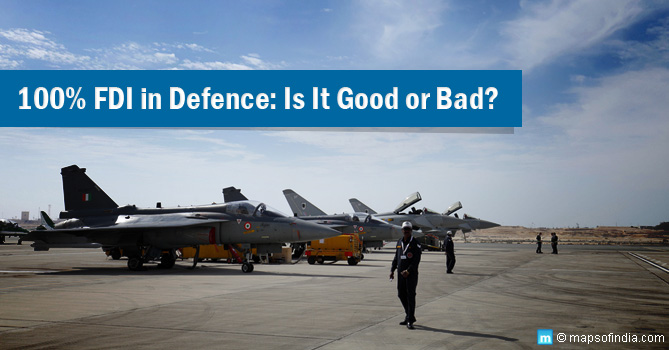NDA Government’s Liberalization Policy
One of the key buzzwords that the NDA government has brought into sharp focus ever since it took over at the Centre in 2014 is “FDI Liberalization”. The very first NDA-engineered Union Budget for FY 2014-15 saw an increase in the foreign direct investment (FDI) limits in insurance sector and defence sectors to 49 percent. Later, in November 2015, the NDA government once again initiated a slew of liberalization policies. The government eased FDI norms in a number of key sectors including civil aviation, construction, defence and media. Thus, the government allowed Foreign Investment Promotion Board (FIPB) to give FDI proposals of up to INR 5,000 crore a clear “go-ahead”. The limit prior to this liberalization move was INR 3000 crore.
Last week, the government made another announcement that is set to make India one of the most coveted investment destinations in this part of the world. The Modi-led government’s decision to build upon November 2015’s FDI liberalization threw open doors to foreign investors, bringing most of the sectors under the automatic approval route. The PMO statement read, “With these changes, India is now the most open economy in the world for FDI”.
One of the most important changes announced last week include approval for 100 percent FDI in the defence sector. Opening up the defence sector has been on the cards for a long time now and the decision is a very highly debated one too.
What Does 100 percent FDI in Defence Mean?
The government’s current liberalization policy means that foreign companies can now own up to 100 percent equity in the country’s defence manufacturing sector through the automatic government approval route. This also means that the sector is now opening up to accessing newer technology and harnessing these technological advances in defence manufacturing. Prior to this, foreign companies could only own a maximum of 49 percent equity in defence manufacturing units. According to a government statement “Foreign investment beyond 49 percent has now been permitted through government approval route, in cases resulting in access to modern technology in the country or for other reasons to be recorded”. The 100 percent FDI limit for the defence sector is now also applicable to manufacturing of small arms and ammunition.
Implications of Defence Liberalization
The NaMo government’s initiatives to open up the country’s economy, to make India one of the top destinations for foreign investment, to increase the ease of doing business in India have made the country one of 2015’s top 10 FDI destinations (according to the United Nations Council for Trade and Development). FDI has more than doubled since Narendra Modi took over as the Prime Minister.
This new wave of liberalization in defence means that the foreign OEMs (original equipment manufacturers) who needed to form partnerships with Indian firms to enter domestic markets will now be able to operate independently. While this is certain to increase ease of business for the OEMs who can cut short the time spent on negotiations and partnerships, it will also increase the competition for Indian businesses.
This is also likely to bring in a number of advantages. It will ensure that the Indian defence forces have a number of Indian and international options to choose from in terms of procurement. It will ensure that state-of-art-technology is easily available. This will also boost the manufacturing sector in the country and ensure fund flow into building up research and development capabilities.
Reasons to Rethink
While inviting FDI into the country’s various sectors may be great for growth and development, and will certainly provide a big boost to employment opportunities in the country, opening up the defence manufacturing sector to 100 percent FDI is a decision that needs a rethink. It has attracted much criticism and with a good reason.
- Domestic manufacturing industries are at risk of being suppressed. With enhanced fund flow, indigenous manufacturers will face unequal competition. India has been working very hard to develop its manufacturing capabilities and intends to become the manufacturing hub of the world. In fact, the NaMo government’s flagship campaign, ‘Make in India’ is designed to showcase a number of sectors including defence manufacturing as one of India’s strengths. While inviting investments is sure to boost the sector, there is fear that domestic endeavours and enterprise may die out and foreign technology may fully replace Indian systems.
- Another major concern that comes as a natural corollary to the easing of defence FDI norms is compromise of national security. Defence systems of the world are increasingly technology driven. Allowing foreign companies to own 100 percent equity also exposes matters of national security and the very core of our defence systems to remain vulnerable. This also means that India’s foreign policy and defence policy will now be subservient to the nation’s economic policy. There are no longer any guarantees that our defence systems (indigenously manufactured with foreign investment) may not be sabotaged in case of hostility with the nation concerned.
- While easing FDI norms in a number of sectors such as retail etc. may be beneficial for the economy in the long run, opening up defence to 100 percent FDI may not provide any big boost to the inflow of foreign funds. Defence manufacturing is a sector that remains highly capital intensive and the risk levels for investors remain quite high as the ultimate payoff is unpredictable. The investment period also often drags on for decades. The exceptionally high risk levels may make the sector unattractive for investors while at the same time leaving our nation vulnerable. The balance between security and investment may remain skewed due to the government’s policy of 100 percent FDI.
According to critics, removing the “state-of-art technology” clause as a condition for FDI and replacing it with “modern technology” is simply making a cosmetic change. It seems, however, that the NaMo government’s intention behind this radical move was to transform the nation into a defence manufacturing destination and an export giant with the inflow of foreign investment. The idea seems to be a shift from India’s earlier stance of being one of the biggest importers of defence systems to that of a major exporter. While it is sound in principle, how it works in implementation will be the real test of India’s development agenda.





